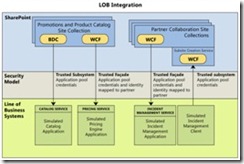Just released from Patterns & Practices: Developing SharePoint Applications
The Patterns & Practices team has recently released new guidance around building collaborative applications on the SharePoint platform.
The goal of this release is to help customers understand how to develop large scale, content-driven SharePoint applications that extend the value of existing line of business systems. It essentially focuses on three primary objectives:
- Large Scale – Show customers how to build a large scale SharePoint application. This includes guidance on building in the manageability, configurability, and performance expected from large scale applications.
- Content Driven – More advanced SharePoint applications often include many sites and combine custom coded logic with created content. The guidance demonstrates areas like custom navigation and publishing, composing web parts with published information, and managing a consistent UI.
- Extend LOB Systems – SharePoint can aggregate and extend information from Line of Business systems to end users, enhancing structured business process with informal processes through collaboration. The guidance shows how to integrate security considerations into business services, and demonstrate how to create collaborative sites that help manage business events like incident escalations and order exceptions.
 This release integrates new guidance with the original release of the SharePoint Guidance – November 2008 guidance (now retired) into a single download.
This release integrates new guidance with the original release of the SharePoint Guidance – November 2008 guidance (now retired) into a single download.
The guidance package contains the following components:
| Component | Description |
| SharePoint Guidance Library | A set of reusable components that helps developers manage configuration, build repositories for SharePoint lists, log traces and events, and use service location. |
| Guide | The documentation includes a variety of topics, such as how to use design and application patterns, how to integrate LOB systems with SharePoint applications, building scalable applications, upgrading SharePoint applications, and using SharePoint capabilities to create, and deploy content. It also includes the design decisions made for the Partner Portal and Training Management applications and explanations of their implementations. |
| Contoso Partner Portal Reference Implementation | This SharePoint application shows how Contoso created an extranet where it can interact with its partners. Among the items demonstrated are techniques for building manageable and scalable enterprise applications, and how to incorporate publishing and page composition features, flexible navigation, collaboration sites, and LOB integration. It includes more advanced techniques than the Training Management reference implementation and requires Microsoft Office SharePoint Server 2007 with Service Pack 1 or Service Pack 2. |
| Contoso Training Management Reference Implementation | This SharePoint application illustrates how the Contoso Human Resources department manages its training course offerings. It shows how to solve many basic SharePoint challenges that you might encounter when you develop your own applications. Windows SharePoint Services 3.0 is required. |
To download this release, click here.
